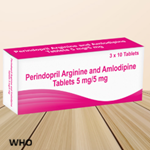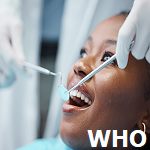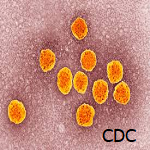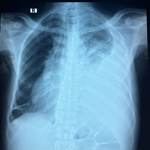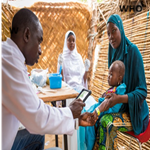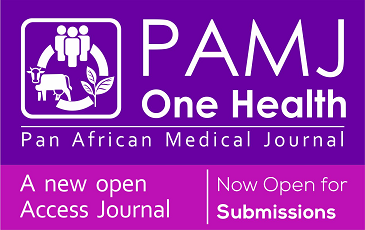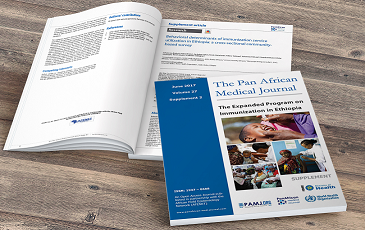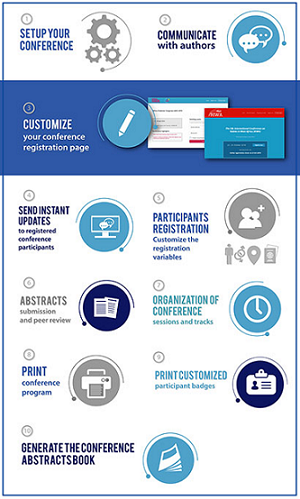Thyroid-associated orbitopathy following COVID-19: a case report
Sabrine Mekni, Hager Khiari, Manel Mekni, Jihene Sayadi, Sawsen Essayeh, Rihab Laamouri, Imen Rojbi, Ibtissem Ben Nacef
Corresponding author: Sabrine Mekni, Department of Endocrinology, Charles Nicolle Hospital, Tunis, Tunisia 
Received: 01 May 2025 - Accepted: 01 Jul 2025 - Published: 09 Jul 2025
Domain: Endocrinology
Keywords: Graves' ophthalmopathy, Graves' disease, SARS-CoV-2, iodine radioisotopes, case report
Funding: This work received no specific grant from any funding agency in the public, commercial, or not-for-profit sectors.
©Sabrine Mekni et al. Pan African Medical Journal (ISSN: 1937-8688). This is an Open Access article distributed under the terms of the Creative Commons Attribution International 4.0 License (https://creativecommons.org/licenses/by/4.0/), which permits unrestricted use, distribution, and reproduction in any medium, provided the original work is properly cited.
Cite this article: Sabrine Mekni et al. Thyroid-associated orbitopathy following COVID-19: a case report. Pan African Medical Journal. 2025;51:71. [doi: 10.11604/pamj.2025.51.71.47807]
Available online at: https://www.panafrican-med-journal.com//content/article/51/71/full
Thyroid-associated orbitopathy following COVID-19: a case report
![]() Sabrine Mekni1,2,3,&, Hager Khiari1,2, Manel Mekni4,
Sabrine Mekni1,2,3,&, Hager Khiari1,2, Manel Mekni4, ![]() Jihene Sayadi4, Sawsen Essayeh1,2,3,
Jihene Sayadi4, Sawsen Essayeh1,2,3, ![]() Rihab Laamouri1,2,3,
Rihab Laamouri1,2,3, ![]() Imen Rojbi1,2,3, Ibtissem Ben Nacef1,2,3
Imen Rojbi1,2,3, Ibtissem Ben Nacef1,2,3
&Corresponding author
Studies have shown a link between COVID-19 vaccination and the development of Graves' disease (GD) and Graves' orbitopathy (GO). However, to the best of our knowledge, this is only the second reported case of clinically overt GO following COVID-19 infection. Herein, we report a 48-year-old female patient who was initially treated in 2017 with radioactive iodine therapy for a toxic thyroid adenoma. In 2021, the patient was diagnosed with COVID-19. Ten days later, she developed bilateral, active, moderate-to-severe GO, accompanied by elevated thyrotropin receptor antibody (TRAb) levels. She was treated with intravenous methylprednisolone followed by oral prednisone and later underwent orbital decompression surgery, followed by strabismus surgery due to worsening diplopia. No complications occurred postoperatively, and her symptoms improved significantly. This case contributes to the literature by suggesting a potential association between COVID-19 infection and the onset of autoimmune diseases, including GO.
Thyroid eye disease (TED) is an autoimmune inflammatory condition that affects the retroocular tissue. It is a debilitating and potentially sight-threatening condition. Most patients with TED (90%) have hyperthyroidism, and approximately 10% are euthyroid or hypothyroid [1]. Graves´ disease (GD) is the most common cause of TED (80%), known as Graves´ orbitopathy (GO). The disease is characterized by an active inflammatory phase followed by a stable and inactive chronic phase [1].
The etiopathogenesis of GD is multifactorial and involves a complex combination of genetic and non-genetic factors. This interplay results in the loss of immune tolerance to thyroid antigens and the initiation of a persistent autoimmune reaction. Infections, among other non-genetic factors, are believed to be crucial in triggering the disease process, particularly in individuals with a genetic susceptibility [2]. Since the COVID-19 pandemic began, millions of people have been affected, and the virus has been shown to cause a multitude of systemic disorders, including immune dysregulation such as autoimmune thyroiditis and GD [2,3]. Few cases of GD and GO after COVID-19 vaccination have been reported [4,5]. Some cases of new-onset GD after COVID-19 infection have been reported [3,6,7], but only one case presented with clinically overt GO [7]. To the best of our knowledge, this is the second reported case of clinically overt GO after COVID-19 infection that developed in a patient initially treated for hyperthyroidism due to TA. Our case contributes to the growing body of evidence in the literature suggesting a potential association between GO and COVID-19 infection.
Patient information: we report the case of a 48-year-old female patient with a history of hyperthyroidism and toxic thyroid adenoma (TA), who was treated with radioactive iodine (RAI) therapy in 2017. Four years later, she was referred to the endocrinology department for TED symptoms with inflammatory features. In February 2017, the patient presented with a nodule in the right thyroid. Thyroid ultrasound showed a 7-mm right nodule classified as European Thyroid Imaging-Reporting and Data System (EU-TIRADS) 3. Blood tests showed low thyroid-stimulating hormone (TSH) at <0.05 mIU/L (normal range 0.4-4) and an elevated free thyroxine (FT4) level of 1.82 ng/dL (normal range 0.7-1.5 ng/dL). Tests for thyroid peroxidase antibodies (TPOAb) and thyroid receptor antibodies (TRAb) were negative. Thyroid scintigraphy revealed a hyperfunctioning nodule ("hot"). The patient was initially treated with benzylthiouracil for three months, followed by RAI therapy in June 2017. She developed hypothyroidism in October 2017, was treated with 100 �g of levothyroxine daily, and had normal thyroid function at subsequent follow-up visits.
Timeline of current episode: the patient was diagnosed with COVID-19 in April 2021.
Clinical findings: ten days later, she developed bilateral eye redness, eyelid fullness, and diplopia. The patient was referred to an ophthalmologist for a TED evaluation. He noted bilateral asymmetric exophthalmos, restrictive ocular dysmotility, and a clinical activity score of 4/7.
Diagnostic assessment: laboratory investigations revealed elevated TSH (8.17 mIU/l) and TRAb concentrations of 2.5 IU/L (normal range <2 IU/L). The results of the blood test are shown in Table 1. The coronal magnetic resonance imaging of the eye showed bilateral proptosis with enlargement of the left inferior and medial rectus muscles and left superior oblique muscle (Figure 1), indicating active, moderate-to-severe GO.
Diagnosis: the diagnosis of overt GO following COVID-19 infection was made based on these findings.
Therapeutic interventions: the patient was treated with 125 �g of levothyroxine daily and intravenous methylprednisolone (1 g/day for three days), followed by oral prednisone (0.5 mg/kg/day) for three months. Significant improvement in inflammatory symptoms was observed, but diplopia worsened, which had an important negative impact on the patient´s quality of life. Once the GO became inactive, the patient underwent decompressive surgery of the orbits, followed by strabismus surgery consisting of recession of the retracted muscles to reduce restrictive dysmotility.
Follow-up and outcome of interventions: Figure 2 shows the evolution of strabismus after surgery. No complications occurred after the surgery.
Patient perspective: the patient was satisfied as her symptoms improved significantly.
Informed consent: written informed consent was obtained from the patient.
Our article presents a rare case of clinically overt GO after COVID-19 infection. Our case contributes to the literature by suggesting a potential association between GD and COVID-19 infection. The main limitation of our study is the report of a single case. Since the start of the COVID-19 pandemic, few cases of new-onset autoimmune thyroid disease have been reported following COVID-19 infection or vaccination [3]. It has been reported that 15% of patients with mild-to-moderate COVID-19 have thyroid dysfunction, and that SARS-CoV-2 can intensify pre-existing autoimmune thyroid disease [3]. Few cases of GD and GO have been reported after COVID-19 vaccination or infection [1,3,5,8,9]. To the best of our knowledge, only one case with clinically overt GO after COVID-19 infection has been observed, making this the second reported case [7].
Our patient was initially treated for hyperthyroidism secondary to TA. She developed hypothyroidism after RAI therapy and was treated with daily levothyroxine. Four years later, she developed TED ten days after the COVID-19 infection, suggesting that the COVID-19 infection plays a role. In fact, COVID-19 infection may act through several mechanisms. Molecular mimicry between viral and self-antigens is the first hypothesis, as various SARS-CoV-2 proteins share genetic similarity or homology with human proteins. COVID-19 activates B lymphocytes that produce antibodies against the virus. These antibodies might cross-react with thyroid antigens and periorbital tissues, causing GD and GO [9]. Furthermore, angiotensin-converting enzyme-2 (ACE2), the primary target of COVID-19, is highly expressed in the thyroid and is potentially implicated in the disease [2,7]. In addition, stimulation of the inflammasome by the release of type 1 interferon may lead to the production of TRAb and the development of GD [9]. Our patient initially tested negative for TRAb. After the infection, laboratory results showed elevated serum TRAb levels. This finding supports our hypothesis. The breakdown of central and peripheral tolerance, as well as psychological stress, may also contribute to the development of Hashimoto's thyroiditis (HT) and GD following COVID-19 infection [2,7].
Another interesting fact about our case was that the patient successively developed two different causes of hyperthyroidism: TA, which was specifically treated with RAI, and GD. GD is reported as an uncommon adverse effect after RAI therapy for TA and toxic multinodular goiter (MNG) [10]. The incidence of GD after RAI has been reported to be 5%, but it increases to 22% in patients who are positive for TPOAb before treatment. This was not the case in our patient, as TPOAb were negative in 2017. Several mechanisms have been proposed to explain the development of autoimmune hyperthyroidism after RAI. These include RAI-induced increases in circulating thyroid-stimulating immunoglobulins and radiation-induced disruption of the balance between T-helper cells and suppressor lymphocytes [10]. GD typically develops 3-6 months after RAI [10]. Our patient developed the condition four years later, which makes the causal link improbable.
Most reported cases of GO after the COVID-19 vaccine were moderate-to-severe and treated with immunosuppressants [1,3,5,8,9]. One case of vision-threatening GO and optic neuropathy after COVID-19 vaccination has been reported in the literature [9]. The patient was treated with immunosuppressants and underwent orbital decompression. Our patient had moderate-to-severe GO and was treated with intravenous corticosteroids. The inflammatory symptoms improved, but the diplopia worsened. As recommended, when the GO became an inactive form, decompressive orbital surgery was performed, followed by strabismus surgery.
This paper outlines a rare case of severe GO that developed after COVID-19 infection, which was effectively managed with intravenous corticosteroids and subsequent surgical intervention. This case highlights a potential association between COVID-19 infection and the onset of GO, underscoring the importance for clinicians to consider this link when evaluating patients presenting with new autoimmune manifestations following COVID-19 infection.
The authors declare no competing interests.
Patient management: all the authors; data collection: Sabrine Mekni, Hager Khiari, and Manel Mekni; manuscript drafting: Sabrine Mekni and Hager Khiari; manuscript revision: Sabrine Mekni and Sawsen Essayeh. All the authors read and approved the final version of this manuscript.
Table 1: hormonal and antibody assessments
Figure 1: coronal T1-weighted (A) and T2-weighted (B) bilateral ocular proptosis grade I on the right side and grade II on the left side, enlargement and T2-weighted fat-saturated hyperintensity of the left inferior and medial rectus muscles and the left superior oblique muscle, measuring 10 mm, 6.5 mm, and 4 mm, respectively (yellow arrow), bilateral increased orbital fat volume more pronounced on the left (red arrow)
Figure 2: A) proptosis and strabismus of the left eye before surgery; B) proptosis and strabismus of the left eye after surgery
- Mohamed A, Tzoulis P, Kossler AL, Dosiou C. New Onset or Deterioration of Thyroid Eye Disease After mRNA SARS-CoV-2 Vaccines: Report of 2 Cases and Literature Review. J Clin Endocrinol Metab. 2023 Mar 10;108(4):979-985. PubMed | Google Scholar
- Marin� M, Latrofa F, Menconi F, Chiovato L, Vitti P. Role of genetic and non-genetic factors in the etiology of Graves´ disease. J Endocrinol Invest. 2015 Mar;38(3):283-94. PubMed | Google Scholar
- Im Teoh JH, Mustafa N, Wahab N. New-onset Thyroid Eye Disease after COVID-19 Vaccination in a Radioactive Iodine-Treated Graves´ Disease Patient: A Case Report and Literature Review. J ASEAN Fed Endocr Soc. 2023;38(1):125-130. PubMed | Google Scholar
- Patrizio A, Ferrari SM, Elia G, Ragusa F, Paparo SR, Mazzi V et al. Graves´ Disease Following SARS-CoV-2 Vaccination: A Systematic Review. Vaccines (Basel). 2022 Sep 1;10(9):1445. PubMed | Google Scholar
- Muller I, Consonni D, Crivicich E, Di Marco F, Curr� N, Salvi M. Increased Risk of Thyroid Eye Disease Following Covid-19 Vaccination. J Clin Endocrinol Metab. 2024 Jan 18;109(2):516-526. PubMed | Google Scholar
- Mateu-Salat M, Urgell E, Chico A. SARS-COV-2 as a trigger for autoimmune disease: report of two cases of Graves´ disease after COVID-19. J Endocrinol Invest. 2020 Oct;43(10):1527-1528. PubMed | Google Scholar
- Lanzolla G, Marcocci C, Marino M. Graves´ disease and Graves´ orbitopathy following COVID-19. J Endocrinol Invest. 2021 Sep;44(9):2011-2012. PubMed | Google Scholar
- Patrizio A, Ferrari SM, Antonelli A, Fallahi P. Worsening of Graves´ ophthalmopathy after SARS-CoV-2 mRNA vaccination. Autoimmun Rev. 2022 Jul;21(7):103096. PubMed | Google Scholar
- Abeillon-du Payrat J, Grunenwald S, Gall E, Ladsous M, Raingeard I, Caron P. Graves´ orbitopathy post-SARS-CoV-2 vaccines: report on six patients. J Endocrinol Invest. 2023 Mar;46(3):617-627. PubMed | Google Scholar
- Yürekli Y, Cengiz A, Güney E. Graves Disease Induced by Radioiodine Therapy for Toxic Nodular Goiter: A Case Report. Mol Imaging Radionucl Ther. 2015 Oct 5;24(3):135-7. PubMed | Google Scholar
Search
This article authors
On Pubmed
On Google Scholar
Citation [Download]
Navigate this article
Similar articles in
Key words
Tables and figures
 Figure 1: coronal T1-weighted (A) and T2-weighted (B) bilateral ocular proptosis grade I on the right side and grade II on the left side, enlargement and T2-weighted fat-saturated hyperintensity of the left inferior and medial rectus muscles and the left superior oblique muscle, measuring 10 mm, 6.5 mm, and 4 mm, respectively (yellow arrow), bilateral increased orbital fat volume more pronounced on the left (red arrow)
Figure 1: coronal T1-weighted (A) and T2-weighted (B) bilateral ocular proptosis grade I on the right side and grade II on the left side, enlargement and T2-weighted fat-saturated hyperintensity of the left inferior and medial rectus muscles and the left superior oblique muscle, measuring 10 mm, 6.5 mm, and 4 mm, respectively (yellow arrow), bilateral increased orbital fat volume more pronounced on the left (red arrow)





